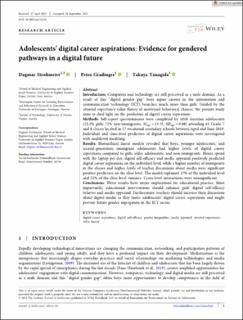| dc.contributor.author | Strohmeier, Dagmar | |
| dc.contributor.author | Gradinger, Petra | |
| dc.contributor.author | Yanagida, Takuya | |
| dc.date.accessioned | 2023-12-11T13:40:05Z | |
| dc.date.available | 2023-12-11T13:40:05Z | |
| dc.date.created | 2023-11-09T13:10:48Z | |
| dc.date.issued | 2023-10 | |
| dc.identifier.citation | Strohmeier, D., Gradinger, P., Yanagida, T. (2023) Adolescents' digital career aspirations: Evidence for gendered pathways in a digital future. Journal of Adolescence. | en_US |
| dc.identifier.issn | 0140-1971 | |
| dc.identifier.uri | https://hdl.handle.net/11250/3106879 | |
| dc.description.abstract | Introduction
Computers and technology are still perceived as a male domain. As a result of this “digital gender gap” boys aspire careers in the information and communication technology (ICT) branches much more than girls. Guided by the situated expectancy-value theory of motivated behavioral choices, the present study aims to shed light on the predictors of digital career aspirations.
Methods
Self-report questionnaires were completed by 1018 Austrian adolescents (52.3% girls; 72% non-immigrants; Mage = 13.55, SDage = 0.88) attending 61 Grade 7 and 8 classes located in 17 vocational secondary schools between April and June 2019. Individual and class-level predictors of digital career aspirations were investigated with multilevel modeling.
Results
Hierarchical linear models revealed that boys, younger adolescents, and second-generation immigrant adolescents had higher levels of digital career aspirations compared to girls, older adolescents, and non-immigrants. Hours spend with the laptop per day, digital self-efficacy and media appraisal positively predicted digital career aspirations on the individual level, while a higher number of immigrants in the classes and higher levels of teacher discussions about media were significant positive predictors on the class level. The model explained 17% of the individual level and 52% of the class level variance. Cross-level interactions were nonsignificant.
Conclusions
These results have major implications for educational practice. Most importantly, educational interventions should enhance girls' digital self-efficacy believes and media appraisal. Furthermore, teachers should increase their discussion about digital media as they foster adolescents' digital career aspirations and might prevent future gender segregation in the ICT sector. | en_US |
| dc.language.iso | eng | en_US |
| dc.publisher | Wiley Periodicals LLC on behalf of Foundation for Professionals in Services to Adolescents | en_US |
| dc.rights | Attribution-NonCommercial-NoDerivatives 4.0 Internasjonal | * |
| dc.rights.uri | http://creativecommons.org/licenses/by-nc-nd/4.0/deed.no | * |
| dc.subject | ungdommer | en_US |
| dc.subject | utdanningsvitenskap | en_US |
| dc.title | Adolescents' digital career aspirations: Evidence for gendered pathways in a digital future | en_US |
| dc.type | Peer reviewed | en_US |
| dc.type | Journal article | en_US |
| dc.description.version | publishedVersion | en_US |
| dc.rights.holder | © 2023 The Authors. | en_US |
| dc.subject.nsi | VDP::Samfunnsvitenskap: 200::Psykologi: 260 | en_US |
| dc.subject.nsi | VDP::Samfunnsvitenskap: 200::Pedagogiske fag: 280 | en_US |
| dc.source.pagenumber | 0 | en_US |
| dc.source.journal | Journal of Adolescence | en_US |
| dc.identifier.doi | 10.1002/jad.12258 | |
| dc.identifier.cristin | 2194572 | |
| cristin.ispublished | true | |
| cristin.fulltext | original | |
| cristin.qualitycode | 1 | |

